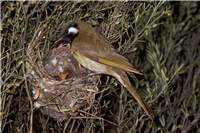Family
Meliphagidae
Genus
Lichenostomus
Species
leucotis
Threats/Control Methods - Regional
Cats (Felis catus) threaten the birds, however the major problem for this species is land clearing, as their regional woodland habitat is considered an Endangered Ecological Community.
Threats/Control Methods - Local
The loss of eucalypt trees from suburban areas is limiting available resources for this species.
Local/Urban Actions
Cat owners can consider de-sexing their pets and providing a stimulating indoor or enclosed environment for them to enjoy, without the opportunity to hunt. Planting native eucalypts in backyards or participating in tree planting actions will provide more habitat for this species.
Common Names
White-eared Honeyeater, New Norcia Honeyeater
Distinguishing Features
The White-eared Honeyeater a medium sized, 19-22cm bird with an olive-green body. It has a black head and throat with a bold white patch below its red eyes. Its strong black bill is not as long or as curved as other honeyeaters.
Survey Techniques
Call and visual identification.
Species Call
A loud, full 'beer-brick' or a mellow yet metallic 'chwok, chwok, choku-whit'.
Similar Species
This honeyeater is very different to others and its distinct colourings and strong bill make it unique.
Distribution
The White-eater Honeyeater is found in highest abundance in the mountains crossing the VIC and NSW border, however its range extends across most of the southeast Australian mainland.
Country of Origin
Australia
Conservation (Pet/Pest) Status - Regional
The population numbers are stable. This species migrates with altitude and is only found in Canberra parks and gardens in autumn and winter, before moving to the nearby high country to breed in spring.
Conservation (Pet/Pest) Status - National
Secure, not listed under the EPBC Act 1999.
LSCCES Population
The surveys recorded only low values, in autumn and winter, in the ANBG, ANU and CSIRO.
Associated vegetation community
The white-eared Honeyeater lives in eucalypt forest, woodland, heath and scrubland.
Limiting Resources
This species depends on a good range of fairly mature eucalypt trees for insect foraging. They also require areas with thick ground vegetation and shrubs for nesting.
Breeding
Breeding events near Canberra take place in the surrounding highlands over the warmer months from October to March. The nest is a deep cup, built on small branches close to the ground of grass and bark shreds. The 2-3 eggs are protected by a lining of hair and wool and incubated by the female. Both parents share feeding the young.
Behaviour
This species is less social than other honeyeaters, preferring to spend time alone or sometimes with one other bird. In nesting season, White-eared Honeyeaters are known to feed and care for Fan-tailed Cuckoos (Cacomantis flabelliformis ).
Functional Group
Food Species
The White-eared Honeyeater forage under strips of eucalypt bark and feeds mainly on insects and spiders, but will also eat nectar, fruit, dewy insect by-products or seeping tree truck wounds.
Predators
Cats (Felis catus) will hunt this species when they are in the suburbs.
Interesting Fact
The White-eared Honeyeater has a habit of collecting hair from people's heads to line its nest.
References - (reader suitability of references, P=Primary teachers, S=Secondary students, T=Tertiary students and researchers)
Books:Freudenberger, D. 2001. Bush for the birds: Biodiversity enhancement guidelines for the Saltshaker Project, Boorowa, NSW. Consultancy report to Greening Australia ACT and SE NSW Inc. CSIRO Sustainable Ecosystems. Canberra. S, T
Longmore, W. 1991. Honeyeaters and their Allies of Australia. CollinsAngus&Robertson Publishers Australia. NSW. P, S, T
Morcombe, M. 2000. Field Guide to Australian Birds. Steve Parish Publishing. Archerfield. Australia P, S, T
Taws, N. et al. 2001. Bringing Birds Back: A Glovebox Guide for Bird Identification and Habitat Restoration in ACT and SE NSW. Greening Australia ACT and SE NSW Inc. P, S, T
Veerman, P. 2003. Canberra Birds: A report on the first 21 years of the garden bird survey. Philip Veerman and Canberra Ornithologists Group. Canberra. S, T
Internet: Birds in Backyards. 2006. [online]. Available at:http://www.birdsinbackyards.net P, S, T
Canberra Ornithological Group (COG). 2004. Birds of Canberra Gardens. COG and the ACT Department of Urban Services. [online]. Available at:http://garden.canberrabirds.org.au/ P, S, T
Online Publications:ACT Government. 2004. Woodlands for Wildlife: ACT Lowland Woodland Conservation Strategy. Action Plan No. 27. Environment ACT, Canberra. [online]. Available at: http://www.environment.act.gov.au/nativeplantsandanimals/threatecspec/woodlandsstrategy S, T
Nix, H. and Cunningham, R. 2006. Birds of the Lower Sullivans Creek Catchment, Canberra ACT. Prepared for the Life in the Suburbs project using data from the Lower Sullivans Creek Catchment Ecological Survey (LSCCES). Australian National University. Canberra. [online]. Available at: http://www.lifeinthesuburbs.com.au/category.php?id=65 S, T

 Top
Top Top
Top